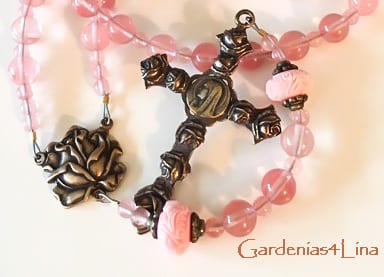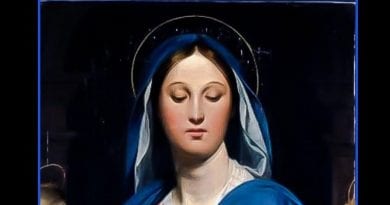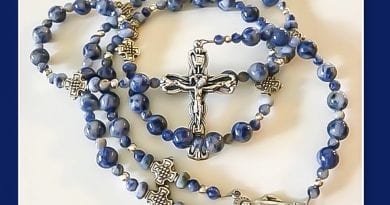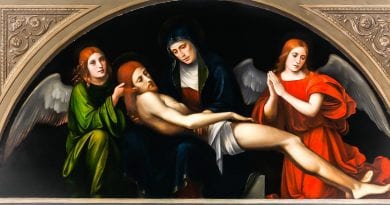The Origin of the Rosary
What is the Origin of the Rosary?
The word Rosary is derived from the Latin word, “rosarium” which means “crown, garland, or garden of roses”.
Crown of Roses
Many have a devotion to the Rosary. We pray it daily. We know that praying the Rosary brings great blessings to us and to the world. We love the feel of the beads in our hands as we pray our way through this sacred strand and contemplate each mystery. Most of us know its history from Saint Domenic’s vision forward but how much do we know about the Rosary’s actual origin?
According to the Catholic Encyclopedia, there is an early legend which made its way through Europe and reached Abyssinia connecting this name with a story of Our Lady. The story tells that Mary was seen taking rosebuds from the lips of a young monk as he was reciting Hail Marys. He wove the rosebuds into a garland which she placed upon her head.
From this legend, came our belief that each time we pray a Hail Mary we are giving Our Blessed Mother
A Brief History
Prayer beads are not exclusive to Catholicism. Throughout history, repetitive prayer, also known as a mantra, was used in many religions. Buddhists and Hindu monastics began the use of circular beads on strings to chant continuously. In early Christianity, the repetition of a short verse from the Psalms or of the Our Father became very popular, especially in the monasteries of Egypt.
Although there was a ban against “vain repetitions”, it did not extend to liturgical prayer or repeated personal prayers which were said slowly and meaningfully and meditated upon. An example of repetitive prayer is Jesus, Himself, during His Agony in the Garden when He prayed for long hours repeating a short phrase:
“…Abba, Father, for You all things are possible; remove this cup from me, yet, not what I want, but what You want . . . And again He went away and prayed, saying the same words.” (Mark 14: 36-39).
The Jesus Prayer ~ Saint Basil
During the fourth century AD, the practice of reciting what was called the Jesus Prayer was prime among Eastern monastics. The Jesus Prayer had a number of forms including:
Lord Jesus Christ, Son of God, have mercy on me a sinner
Lord Jesus Christ, have mercy on me
Lord Jesus Christ, by the Mother of God, have mercy on me a sinner.
Lord have mercy.
Saint Basil (Bishop of Caesarea, and a Doctor of the Church) suggested the praying of the Jesus Prayer, in place of reading the Psalms, for those who could not read and also for those who were traveling and who were held back from using the liturgical books in their prayer. He then ordered the use of a counting device; a woolen cord of 100 knots, divided every 25 knots with a larger or other knot or bead.
Before Saint Basil’s time, Christian monastics used loose beads and small rocks in bags to count their repeated prayers. Saint Paul, the First Hermit (D.C. 345) had a bag of 300 beads and placed them, one by one, into another bag as he prayed. (Interestingly, this is exactly how Saint Clare of Assisi prayed, centuries later.) Later, beads, pebbles, berries or discs of bone were strung on a rope.
Rocks, Berries, and Beads Become the “Rosary”
Beads and other materials were later used for prayer cords and prayer chains. We have come to know them as the “Rosary” (“rosarium”).
Western use of the prayer cord initially involved the praying of Our Father’s in place of the Psalter for those who could not read; one Our Father for each of the 150 psalms. The Hail Mary was also used and soon the “Rosary” or “Psalter of the Virgin Mary” came into being. This consisted in the recitation of 50 or 150 Hail Mary’s. The mysteries of the rosary were introduced by Dominic of Prussia sometime between 1410 and 1439.
Other Forms of the Rosary
There are other versions of the rosary.
The Golden Rosary is made up of 63 beads for 63 Hail Mary’s in honor of the years the Virgin Mary lived on earth. This was a tradition of the Brigantine Monk. The Golden Rosary is still used today in Schrocken in the Vorarlberg Alps. No Our Father beads are included on this version of the rosary. Other configurations included 72 beads for the Franciscan Crown Rosary, three decades and even one decade or “tenners” which were especially popular with pilgrims. Rosary rings and tenners were popular during the Irish Penal times when Catholicism was banned in Ireland.
The “telling of the beads” became so important a prayer that wealthy nobles often paid to have an individual follow them around saying the rosary for them at all times. They were called “beadsmen”.
According to The National Assembly of Hebrew Students, Old Testament Jews were instructed by the Torah to put fringe on the four corners of their garments to help them remember to observe all the commandments. These fringes are tied in special ways and do look like prayer ropes. While they are not necessarily designed to be used as prayer counters, many devout Jews do count their prayers on the knots of the fringes.
Origin of the Rosary as We Know it Today
There is some disagreement as to how the Rosary, in its present form, originated. The use of knotted prayer ropes dates back to the third century and as we know, they were used for the Jesus Prayer. After the First Council of Ephesus in 431, there was a slow but sure growth in the use of Marian prayers.
Most Catholics believe that the Rosary was given by Our Lady to Saint Domenic during one of his visions and was later promoted by Blessed Allan de la Roche. But not all Catholics are in agreement with this. Some historians see a more gradual growth of the Rosary because the repetition of Marian prayers, which form the basis of the Rosary, needed to be counted and this resulted in the modern form of the Rosary prayed on beads.
The practice of meditation while praying the Ave Marias was accredited to Dominic of Prussia, a 15th-century Carthusian monk. Domenic referred to it as the “Life of Jesus Rosary” or vita Christi Rosarium. In 1977, however, Andreas Heinz, a theologian from Trier, discovered a vita Christi Rosary that dated to 1300. This discovery recommended that the origin of the current rosary extends back to, at least, that time.
The Rosary, being made up of the Our Father and the Hail Mary, was the first Catholic devotion prayed through the centuries. It was not, however, until 1214 that the Church received the Rosary in the configuration that we have today. In 1214, it was given to the Church by Saint Domenic.
The Rosary ~ Saint Domenic and Converting the Albigensiansthe
The Rosary was given to the Church by Saint Dominic who received it from the Blessed Virgin as a means of converting the Albigensians. (Heretics of the 12th and 13th century).
Saint Domenic was devastated by the degree of people’s sinfulness and withdrew into a forest near Toulouse to pray. He prayed constantly for three days and nights. As he prayed, he wept and offered penances in an effort to calm God’s anger. His body became badly bruised, he became weak and fell into a coma. It was at this point that Mary, accompanied by three angels, appeared to him. She spoke, “Dear Dominic, do you know which weapon the Blessed Trinity wants to use to reform the world?” Saint Domenic replied, “Oh, my Lady, you know far better than I because next to your Son Jesus Christ you have always been the chief instrument of our salvation.” Our Lady answered, “I want you to know that, in this kind of warfare, the battering ram has always been the Angelic Psalter which is the foundation stone of the New Testament. Therefore if you want to reach these hardened souls and win them over to God, preach my Psalter.”
Comforted and filled with excitement for the conversion of these heretics, he went to the Cathedral. Unseen angels rang the bells to gather the people together and Saint Dominic began to preach.
As he began his sermon, a horrid storm began. The earth shook, the sun darkened and the thunder and lightning were so fierce that those in the Cathedral became frightened. Their fear became greater when they looked at an image of Our Lady which was shown in a prominent place. They saw her raise her arms to heaven three times as she called God’s vengeance upon them if they did not convert, change their lives, and seek her protection.
The storm came to an end, and Saint Domenic continued preaching. His words were compassionate as he explained the importance of praying the Rosary. Nearly all the people of Toulouse embraced his teaching and relinquished their false beliefs. In a short time, the town became peaceful and its people began leading faithful Christian lives.
Feast of Our Lady of the Rosary
In 1571, the Christian victory at the Battle of Lepanto was attributed to the praying of the Rosary by masses of Europeans in response to the request of Pope Pius V. This eventually resulted in the Feast of Our Lady of the Rosary. In 1569, the papal bull Consueverunt Romani Pontifices established the devotion to the rosary in the Catholic Church. In 2002 Saint John Paul II added the Luminous Mysteries which he based on a compilation by Saint George Preca. In his letter, Rosarium Virginis Mariae (2002), Pope John Paul II introduced them as an option.
“When the Holy Rosary is said well, it gives Jesus and Mary more glory and is more meritorious than any other prayer”.
~Saint Louis de Montfort~
Marilyn Nash
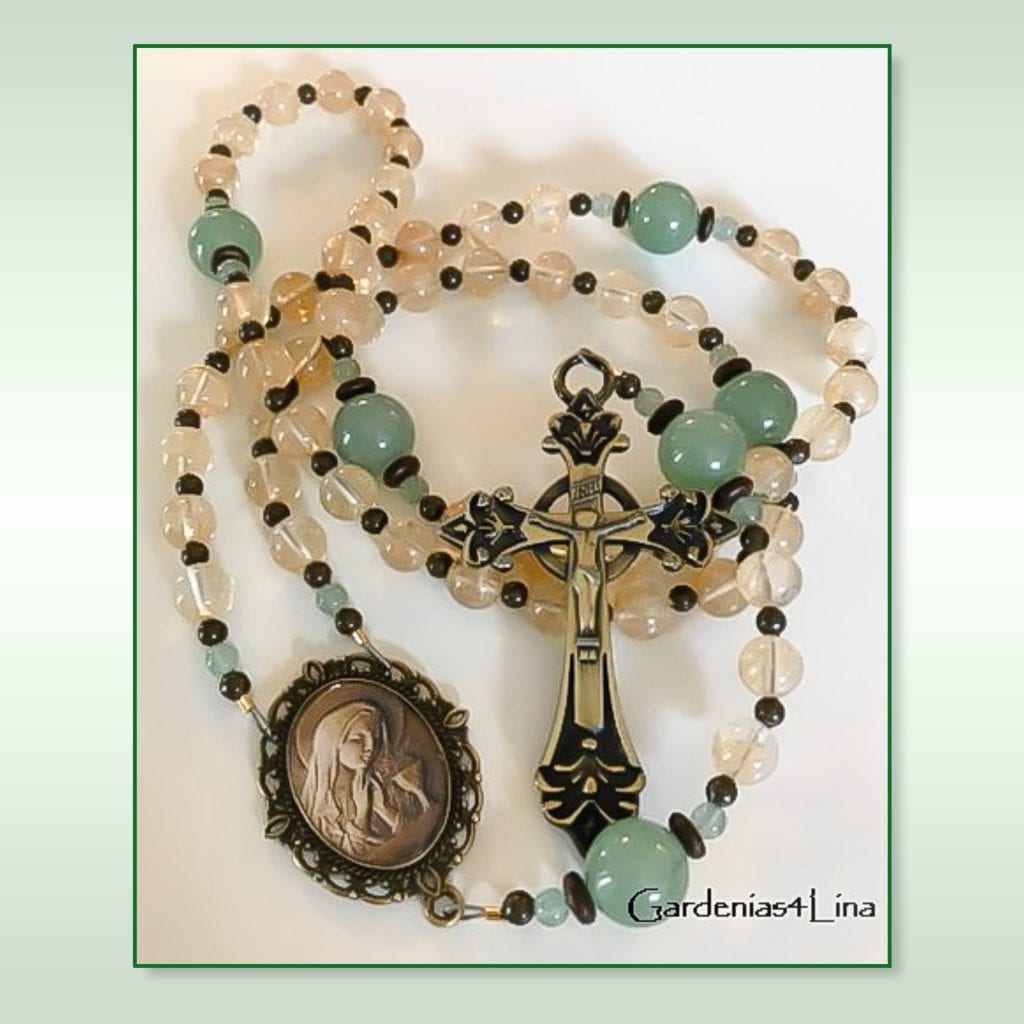
Limited Edition Rosary ~ Solemnity of Mary
www.Gardenias4Lina.com

